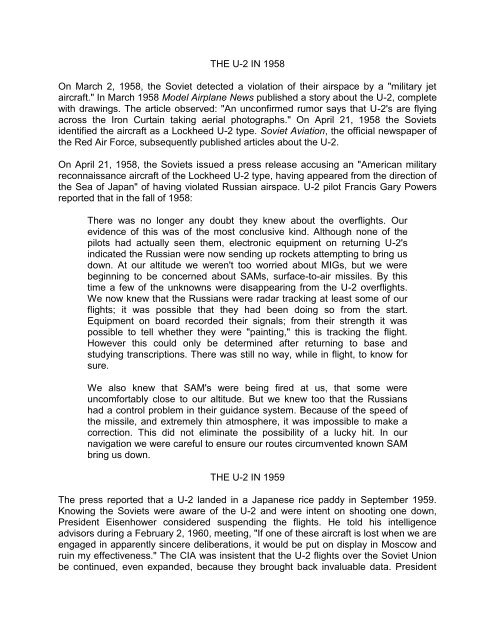NODULE X7 OSWALD IN MINSK AND THE U2 DUMP: JANUARY ...
NODULE X7 OSWALD IN MINSK AND THE U2 DUMP: JANUARY ...
NODULE X7 OSWALD IN MINSK AND THE U2 DUMP: JANUARY ...
You also want an ePaper? Increase the reach of your titles
YUMPU automatically turns print PDFs into web optimized ePapers that Google loves.
<strong>THE</strong> U-2 <strong>IN</strong> 1958<br />
On March 2, 1958, the Soviet detected a violation of their airspace by a "military jet<br />
aircraft." In March 1958 Model Airplane News published a story about the U-2, complete<br />
with drawings. The article observed: "An unconfirmed rumor says that U-2's are flying<br />
across the Iron Curtain taking aerial photographs." On April 21, 1958 the Soviets<br />
identified the aircraft as a Lockheed U-2 type. Soviet Aviation, the official newspaper of<br />
the Red Air Force, subsequently published articles about the U-2.<br />
On April 21, 1958, the Soviets issued a press release accusing an "American military<br />
reconnaissance aircraft of the Lockheed U-2 type, having appeared from the direction of<br />
the Sea of Japan" of having violated Russian airspace. U-2 pilot Francis Gary Powers<br />
reported that in the fall of 1958:<br />
There was no longer any doubt they knew about the overflights. Our<br />
evidence of this was of the most conclusive kind. Although none of the<br />
pilots had actually seen them, electronic equipment on returning U-2's<br />
indicated the Russian were now sending up rockets attempting to bring us<br />
down. At our altitude we weren't too worried about MIGs, but we were<br />
beginning to be concerned about SAMs, surface-to-air missiles. By this<br />
time a few of the unknowns were disappearing from the U-2 overflights.<br />
We now knew that the Russians were radar tracking at least some of our<br />
flights; it was possible that they had been doing so from the start.<br />
Equipment on board recorded their signals; from their strength it was<br />
possible to tell whether they were "painting," this is tracking the flight.<br />
However this could only be determined after returning to base and<br />
studying transcriptions. There was still no way, while in flight, to know for<br />
sure.<br />
We also knew that SAM's were being fired at us, that some were<br />
uncomfortably close to our altitude. But we knew too that the Russians<br />
had a control problem in their guidance system. Because of the speed of<br />
the missile, and extremely thin atmosphere, it was impossible to make a<br />
correction. This did not eliminate the possibility of a lucky hit. In our<br />
navigation we were careful to ensure our routes circumvented known SAM<br />
bring us down.<br />
<strong>THE</strong> U-2 <strong>IN</strong> 1959<br />
The press reported that a U-2 landed in a Japanese rice paddy in September 1959.<br />
Knowing the Soviets were aware of the U-2 and were intent on shooting one down,<br />
President Eisenhower considered suspending the flights. He told his intelligence<br />
advisors during a February 2, 1960, meeting, "If one of these aircraft is lost when we are<br />
engaged in apparently sincere deliberations, it would be put on display in Moscow and<br />
ruin my effectiveness." The CIA was insistent that the U-2 flights over the Soviet Union<br />
be continued, even expanded, because they brought back invaluable data. President


